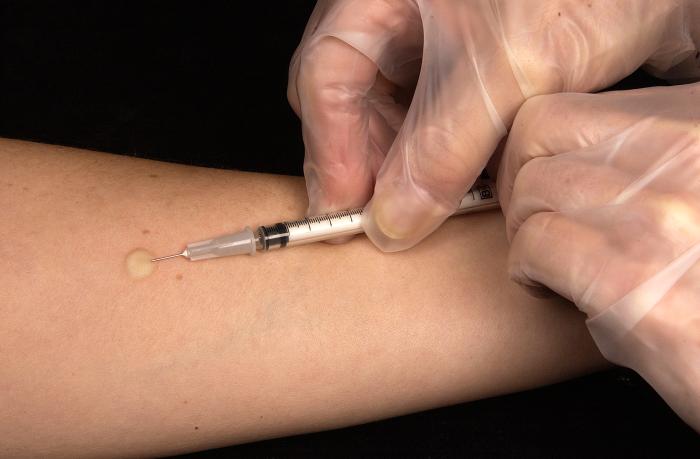Tuberculosis history and symptoms: Difference between revisions
Matt Pijoan (talk | contribs) No edit summary |
|||
| Line 1: | Line 1: | ||
Tuberculosis, or TB is a bacterial infection that kills 3 million people worldwide, more people than any other infection in the world. Approximately one-third of the world is infected, and 15 million people in the US. Active tuberculosis kills 60% of the time if not treated, but treatment cures 90% of patients. Most people are infected with TB have latent TB. This means that the bacteria is controlled by the body's immune system. People with latent TB do not have symptoms and cannot transmit TB to other people. However, later if the infected person has a weakened immune system (AIDS, young children, elderly, sick with other diseases, etc.), the bacteria can break out leading to active TB, or TB disease. | Tuberculosis, or TB is a bacterial infection that kills 3 million people worldwide, more people than any other infection in the world. Approximately one-third of the world is infected, and 15 million people in the US. Active tuberculosis kills 60% of the time if not treated, but treatment cures 90% of patients. Most people are infected with TB have latent TB. This means that the bacteria is controlled by the body's immune system. People with latent TB do not have symptoms and cannot transmit TB to other people. However, later if the infected person has a weakened immune system (AIDS, young children, elderly, sick with other diseases, etc.), the bacteria can break out leading to active TB, or TB disease. | ||
==History and symptoms== | ==History and symptoms== | ||
==History== | ==History== | ||
{{#widget:SchemaSnippet}} | |||
{{details|Tuberculosis diagnosis}} | {{details|Tuberculosis diagnosis}} | ||
[[Image:Mantoux tuberculin skin test.jpg|thumb|right|350px|[[Mantoux test|Mantoux tuberculin skin test]]]] | [[Image:Mantoux tuberculin skin test.jpg|thumb|right|350px|[[Mantoux test|Mantoux tuberculin skin test]]]] | ||
| Line 40: | Line 36: | ||
==References== | ==References== | ||
{{reflist|2}} | {{reflist|2}} | ||
Revision as of 18:44, 3 July 2012
Tuberculosis, or TB is a bacterial infection that kills 3 million people worldwide, more people than any other infection in the world. Approximately one-third of the world is infected, and 15 million people in the US. Active tuberculosis kills 60% of the time if not treated, but treatment cures 90% of patients. Most people are infected with TB have latent TB. This means that the bacteria is controlled by the body's immune system. People with latent TB do not have symptoms and cannot transmit TB to other people. However, later if the infected person has a weakened immune system (AIDS, young children, elderly, sick with other diseases, etc.), the bacteria can break out leading to active TB, or TB disease.
History and symptoms
History

Tuberculosis can be a difficult disease to diagnose, due mainly to the difficulty in culturing this slow-growing organism in the laboratory. A complete medical evaluation for TB must include a medical history, a chest X-ray, and a physical examination.
A complete medical evaluation for TB includes the following:
- Medical History: Clinicians should ask about the patient’s history of TB exposure, infection, or disease. It is also important to consider demographic factors (e.g., country of origin, age, ethnic or racial group, occupation) that may increase the patient’s risk for exposure to TB or to drug-resistant TB. Also, clinicians should determine whether the patient has medical conditions, especially HIV infection, that increase the risk of latent TB infection progressing to TB disease.
When the disease becomes active, 75% of the cases are pulmonary TB. Pulmonary TB disease should be suspected in persons who have the following symptoms
- Chest pain
- Hemoptysis (Coughing up blood)
- Productive, prolonged cough for more than three weeks
- Unexplained weight loss
- Loss of appetite
- Night sweats
- Chills
- Fever
- Fatigue
- Pallor
In the other 25% of active cases, the infection moves from the lungs, causing other kinds of TB more common in immunosuppressed persons and young children. Extrapulmonary infection sites include:
- Pleura
- Central nervous system in meningitis
- Lymphatic system in scrofula of the neck
- Genitourinary system in urogenital tuberculosis
- Bones and joints in Pott's disease of the spine
An especially serious form is disseminated TB, more commonly known as miliary tuberculosis. Although extrapulmonary TB is not contagious, it may co-exist with pulmonary TB, which is contagious.[1]
References
- ↑ Centers for Disease Control and Prevention (CDC), Division of Tuberculosis Elimination. Core Curriculum on Tuberculosis: What the Clinician Should Know. 4th edition (2000). Updated Aug 2003.